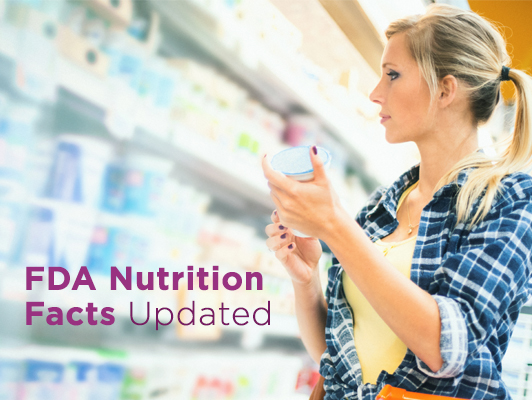New Nutrition Facts labels explained

In May the FDA announced its finalization of the new Nutrition Facts labels estimated to take place in 2018. The current label is more than 20 years old, so it was time to make some important changes that will benefit consumers. As you would expect, careful consideration went into the decision to change based on updated scientific information, nutrition and public health research, and recommendations from expert groups and the public.
According to FDA Commissioner Dr. Robert Califf, “The updated label makes improvements to this valuable resource so consumers can make more informed food choices — one of the most important steps a person can take to reduce the risk of heart disease and obesity.”
But how? Keep reading; we have simplified the highlights of the changes for you here.
Labels will have a refreshed design. The look of the labels will change to help consumers better understand serving size, calories, vitamins and daily value percentages. Changes include:
- Increased type size for calories, servings per container, and serving size
- Bolding of the type for calories and serving size
Labels will reflect updated nutrition science. A lot of research has taken place since 1993, the last time the labels were updated. We not know a lot more about how the foods we eat impact our overall health and wellness. Changes include:
- Scientific evidence supports that it can be challenging to stay within calorie limits if you consume more than 10 percent of daily calories from added sugars. The new labels will include added sugars in grams as a percentage of Daily Value to help consumers know how much sugar has been added to the product.
- When the last changes to the labels were made American diets were deficient in vitamin A and C, which has not been the case in recent years. Because of that, these will no longer be required on the label.
- Research is showing that type of fat rather than amount of fat is more important. Total fat, saturated fat, and trans fat will be listed on the label but calories from total fat will be removed.
- Consumers are not getting enough Vitamin D or potassium, which can increase risk for chronic disease. So declarations of Vitamin D and potassium will have actual gram amount as well as percent daily values.
- Since daily values can be helpful for consumers in understanding nutrition information, the footnote is being changed to better explain daily values. It will read: “*The % Daily Value tells you how much a nutrient in a serving of food contributes to a daily diet. 2,000 calories a day is used for general nutrition advice.”
Updates to serving size and labeling requirements:
- The amount of food and drink people consume has changed in the past decades. By law, the Nutrition Labeling and Education Act requires serving sizes to be based on what people actually eat rather than what they should be eating. For example:
- Serving sizes for soda will change from 8 oz. to 12 oz.
- Serving sizes for ice cream will change from ½ cup to ⅔ cup.
- It’s important for consumers to understand the calories and nutrients they are getting if they consume a serving or an entire unit of a product. For that reason, for certain products that are between 1 and 2 servings that could be consumed in one sitting or multiple sittings, manufacturers will have to provide “dual column” labels to indicate the amount of calories and nutrients on both a “per serving” and “per package”/“per unit” basis.
Label format: Original vs. new (from FDA)

Note: The images above are meant for illustrative purposes to show how the new Nutrition Facts label might look compared to the old label. Both labels represent fictional products. When the original hypothetical label was developed in 2014 (the image on the left-hand side), added sugars was not yet proposed so the “original” label shows 1g of sugar as an example. The image created for the “new” label (shown on the right-hand side) lists 12g total sugar and 10g added sugar to give an example of how added sugars would be broken out with a % Daily Value.
Now that you understand the updated Nutrition Facts labels, it is time to use your newfound knowledge to make healthier, more informed food choices. Happy snacking!
References:
US Food and Drug Administration: www.fda.gov/Food/GuidanceRegulation/GuidanceDocumentsRegulatoryInformation/LabelingNutrition/ucm385663.htm



